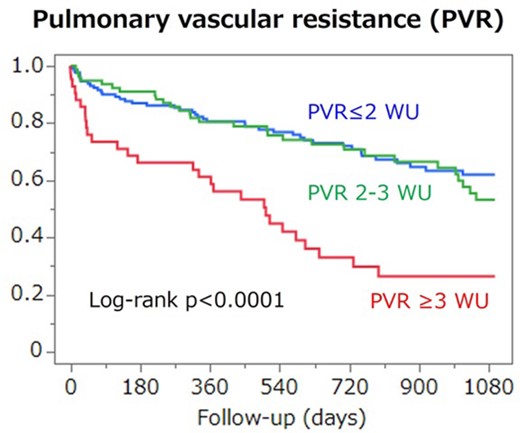-
PDF
- Split View
-
Views
-
Cite
Cite
F Sera, T Ohtani, M Seo, T Hayashi, M Yano, A Nakagawa, Y Nakagawa, S Tamaki, T Yamada, Y Yasumura, S Hikoso, K Okada, D Nakatani, Y Sotomi, Y Sakata, The OCVC-Heart Failure Investigators, The impact of the 2022 definition of pulmonary hypertension on long-term clinical outcomes in patients with heart failure with preserved ejection fraction, European Heart Journal, Volume 45, Issue Supplement_1, October 2024, ehae666.1193, https://doi.org/10.1093/eurheartj/ehae666.1193
Close - Share Icon Share
Abstract
Backgrounds: In recent years, the definitions of pulmonary hypertension (PH) have been revised for early diagnosis and risk stratification of patients with PH. Using the 2015 definitions, the development of a precapillary component of PH in addition to a postcapillary PH was associated with right heart dysfunction and poor prognosis in patients with heart failure (HF) with preserved ejection fraction (HFpEF). However, the prognostic impact of revised definitions of PH in patients with HFpEF has not been fully evaluated.
We investigated the impact of the 2018 and 2022 ESC/ERS definitions of PH on long-term clinical outcomes using data from a prospective, multicenter, observational study of patients with HFpEF (PURSUIT-HFpEF).
A total of 250 patients hospitalised with acute HF who underwent right heart catheterisation after initial HF treatment were divided into PH categories according to the 2018 and 2022 definitions: isolated postcapillary PH (Ipc-PH), precapillary PH, combined postcapillary and precapillary PH (Cpc-PH), and unclassified PH. The incidence of the composite endpoint of all-cause death and HF rehospitalisation after discharge was compared across the PH categories.
The overall prevalence of PH defined as a mPAP > 20 mmHg was 54%. Applying the 2022 definition, 42 patients (17%) were reclassified as either precapillary PH or Cpc-PH, resulting in a significant increase in the propotion of patients classified as having PH with a precapillary component (precapillary PH and Cpc-PH) compared with the 2018 definition (26% vs. 11%, p<0.0001). At a median follow-up of 822 days after discharge, PH with a precapillary component was associated with poor clinical outcomes according to the 2018 definition (Figure 1A), but according to the 2022 definition, clinical outcomes did not differ across the PH categories (Figure 1B). PVR ≥3 Wood units (WU) was a significant prognostic indicator, but there was no significant difference between the PVR 2-3 WU and PVR ≤2 WU categories (Figure 2).


Author notes
Funding Acknowledgements: Type of funding sources: Foundation. Main funding source(s): This work was funded by Roche Diagnostics K.K. and Fuji Film Toyama Chemical Co. Ltd.
- heart failure, acute
- catheterization of right heart
- heart failure
- pulmonary hypertension
- follow-up
- patient prognosis
- treatment outcome
- pulmonary artery line
- ejection fraction
- right side of heart
- stratification
- cardiac progenitor cells
- heart failure with preserved ejection fraction
- early diagnosis
- wood units
- european society of cardiology
- composite outcomes



